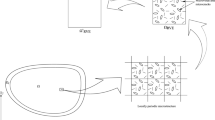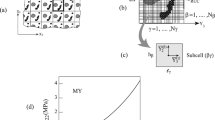Abstract
A novel framework and integration scheme has been developed to implement a secant-based homogenization theory for particle-reinforced plasticity into an existing damage-based constitutive model. In this approach, the material is envisaged as a three-phase composite composed of voids and particles embedded in a ductile matrix. Two successive homogenization theories (damage- and particle-based) are then applied to determine the macro-mechanical response of the material as well as the average stress state within the constituents as a function of the particle shape, composition and volume fraction. By identifying the stress state within the particles and the matrix, void nucleation can be accurately represented and the void growth and coalescence models are improved through knowledge of the stress state within the matrix. The performance of this loosely coupled model is analytically evaluated using idealized composite materials that contain inclusions of various shapes to elucidate the influence of the inclusion morphology on damage evolution and coalescence. The present work provides an efficient, albeit approximate, algorithm that can be readily included into existing damage-based constitutive models to improve their predictions of damage evolution, particularly related to void nucleation.


Similar content being viewed by others
References
Zhang Z., Niemi E.: Studies on the ductility predictions by different local failure criteria. Eng. Fract. Mech. 48, 529–540 (1994)
Zhang Z., Niemi E.: Analyzing ductile fracture using dual dilational constitutive equations. Fatig. Fract. Eng. Mater. Struct. 17, 695–707 (1994)
Gologanu, M., Leblond, J.-B., Perrin, G., Devaux, J.: Recent extensions of Gurson’s model for porous ductile metals. In: Suquet, P. (ed.) Continuum Micromechanics, pp. 61–130. Springer, New York (1997)
Pardoen T., Hutchinson J.W.: An extended model for void growth and coalescence. J. Mech. Phys. Solids 48, 2512–2567 (2000)
Zhang Z., Thaulow C., Odegard J.: A complete Gurson model approach for ductile fracture. Eng. Fract. Mech. 67, 155–168 (2000)
Benzerga A.A.: Micromechanics of coalescence in ductile fracture. J. Mech. Phys. Solids 50, 1331–1362 (2002)
Pardoen T.: Numerical simulation of low stress triaxiality ductile fracture. Comput. Struct. 84, 1641–1650 (2006)
Lassance D., Scheyvaerts F., Pardoen T.: Growth and coalescence of penny-shaped voids in metallic alloys. Eng. Fract. Mech. 73, 1009–1034 (2006)
Pardoen T.: Numerical simulation of low stress triaxiality ductile fracture. Comp. Struct. 84, 1641–1650 (2006)
Fabregue D., Pardoen T.: A constitutive model for elastoplastic solids containing primary and secondary voids. J. Mech. Phys. Solids 56, 719–741 (2008)
Scheyvaerts F., Pardoen T., Onck P.R: A new model for void coalescence by internal necking. Int. J. Dam. Mech. 19, 95–126 (2010)
Gurson A.L.: Continuum theory of ductile rupture by void nucleation and growth—part I. Yield criteria and flow rules for porous ductile media. J. Eng. Mater. Technol. 99, 2–15 (1977)
Tvergaard V.: Influence of voids on shear band instabilities under plane strain conditions. Int. J. Fract. 17, 389–407 (1981)
Beremin F.M.: Cavity formation from inclusions in ductile fracture of A508 steel. Metall. Trans. A 12, 723–731 (1981)
Chu C.C., Needleman A.: Void nucleation effects in biaxially stretched sheets. J. Eng. Mater. Technol. 102, 249–256 (1980)
Berveiller M., Zaoui A.: An extension of the self-consistent scheme to plastically-flowing polycrystals. J. Mech. Phys. Solids 26, 325–344 (1979)
Weng G.J.: Some elastic properties of reinforced solids, with special reference to isotropic ones containing spherical inclusions. Int. J. Eng. Sci. 22, 845–856 (1984)
Tandon G.P., Weng G.J.: Average stress in the matrix and effective moduli of randomly oriented composites. Compos. Sci. Tech. 27, 111–132 (1986)
Tandon G.P., Weng G.J.: A theory of particle-reinforced plasticity. J. Appl. Mech. 55, 126–135 (1988)
Suquet, P.: Effective properties of nonlinear composites. In: Continuum Micromechanics. CISM Course and Lecture Notes, pp. 197–264 (1997)
Hill R.: Continuum micro-mechanics of elastoplastic polycrystals. J. Mech. Phys. Solids 13, 89–101 (1965)
Gonzalez C., Segurado J., Llorca J.: Numerical simulation of elasto-plastic deformation of composites: evolution of stress microfields and implications for homogenization models. J. Mech. Phys. Solids 52, 1573–1593 (2004)
Doghri I., Ouaar A.: Homogenization of two-phase elasto-plastic composite materials and structures: study of cyclic plasticity and numerical algorithms. Int. J. Solids Struct. 40, 1681–1712 (2003)
Christensen R.M.: A critical evaluation of a class of micro-mechanical models. J. Mech. Phys. Solids 38, 379–404 (1990)
Ponte-Castaneda P.: The effective mechanical properties of nonlinear isotropic composites. J. Mech. Phys. Solids 39, 45–71 (1991)
Kailasam M., Ponte Castaneda P.: A general constitutive theory for linear and nonlinear particulate media with microstructure evolution. J. Mech. Phys. Solids 46, 65–427 (1998)
Ponte-Castaneda P., Suquet P.: Nonlinear composites. Adv. Appl. Mech. 34, 171–301 (1998)
Chaboche J.L., Kanoute P., Roos A.: On the capabilities of mean-field approaches for the description of plasticity in metal-matrix composites. Int. J. Plast. 21, 1409–1434 (2005)
Pierard O., Gonzalez C., Segurado J., Llorca J., Doghri I.: Micromechanics of elasto-plastic materials reinforced with ellipsoidal inclusions. Int. J. Solids Struct. 44, 6945–6962 (2007)
Mueller R., Mortensen A.: Simplified prediction of the monotonic uniaxial stress–strain curve of non-linear particulate composites. Acta Mater. 54, 2145–2155 (2006)
Mori T., Tanaka K.:: Average stress in matrix and average elastic energy of materials with misfitting inclusions. Acta Metall. 21, 571–574 (1973)
Butcher, C. (2011) A multi-scale damage percolation model of ductile fracture. Ph.D. thesis, University of New Brunswick, Canada. http://dspace.hil.unb.ca:8080/handle/1882/35391
Eshelby J.D.: The determination of the elastic field of an ellipsoidal inclusion, and related problems. Proc. R. Soc. Lond. A 241, 376–396 (1957)
Ragab A.R.: Application of an extended void growth model with strain hardening and void shape evolution to ductile fracture under axisymmetric tension. Eng. Fract. Mech. 71, 1515–1534 (2004)
Thomason P.F.: Ductile Fracture of Metals. Pergamon Press, Oxford (1990)
Tohgo K., Mochizuki K.: Damage mechanics approach to material-dependency of fracture toughness in aluminum alloys. Int. J. Dam. Mech. 11, 151–170 (2002)
Worswick M.J., Pelletier P.: Numerical simulation of ductile fracture during high strain rate deformation. Eur. Phys. J. Appl. Phys. 4, 257–267 (1998)
Butcher C., Chen Z.T.: Characterizing void nucleation in a damage-based constitutive model using notched tensile sheet specimens. Theor. Appl. Fract. Mech. 55, 140–147 (2011)
Needleman A.: Continuum model for void nucleation by inclusion debonding. J. Appl. Mech. 54, 525–531 (1987)
Moulin N., Jeulin D., Klöcker H.: Stress concentrations in non-convex elastic particles embedded in a ductile matrix. Int. J. Eng. Sci. 47, 170–191 (2009)
Griffith A.A.: The phenomena of rupture and flow and solids. Phil. Trans. R. Soc. Lond. A 221, 163–198 (1921)
Author information
Authors and Affiliations
Corresponding author
Rights and permissions
About this article
Cite this article
Butcher, C., Chen, Z. & Worswick, M. Integration of a particle-based homogenization theory into a general damage-based constitutive model to improve the modelling of void nucleation to coalescence. Acta Mech 224, 139–156 (2013). https://doi.org/10.1007/s00707-012-0740-y
Received:
Revised:
Published:
Issue Date:
DOI: https://doi.org/10.1007/s00707-012-0740-y




